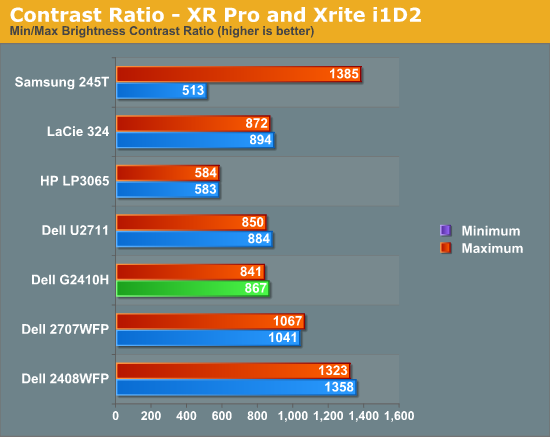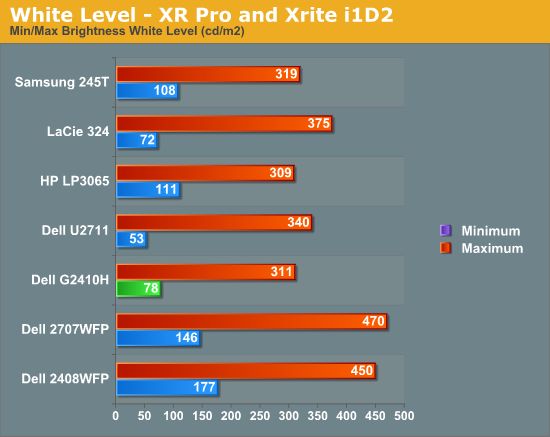Dell G2410H Review: A Green 24" LCD
by Brian Klug on May 7, 2010 1:43 AM EST
White and Black points, Contrast
For brightness, black level, and contrast points, we use the same colorimeter setup described earlier. Specifically, an Xrite i1D2 with ColorEyes Display Pro, and take measurements. Dynamic contrast is always turned off, as this throws off our results. We also let the panels settle in for a half hour at the respective settings before taking any measurements, though with WLED the wake up time is much shorter than a CCFL.



Black level is an important metric, since it directly represents the extinction ratio of the crossed polarizers in the TN cells. Remember, when a pixel is desired to be black, the photoelectric crystal in the cell changes linearly polarized light 90 degrees out of phase, so it is blocked by the polarizer. Higher extinction ratios (and thus better crystals and materials) result in lower (better) black levels.
We recommend running monitors at around 200 nits of luminous intensity, just because this is often where some of the best color tracking sits, and it’s enough of a balance to not result in eye stress from looking around the room and having your pupil adjust. As an aside, I personally am a bit of a light-crazy person and usually crank my displays brightness to the max (I consider 400 nits normal), but forget that I ever said that. ;)
The charts show the dynamic range in brightness, and the respective black levels at each brightness. What we’re really interested in, however, is the contrast ratio. We can see pretty quickly that the G2410H doesn’t meet the advertised 1,000 ratio, but comes close at 867. Performance is pretty consistent as well at both brightness settings.
It’s interesting that the WLED backlit G2410H doesn’t blow the CCFL backlit displays out of the water at maximum brightness. More than likely, Dell has engineered a display that uses as few LEDs as possible for the sake of power savings. The tradeoff there is that maximum intensity isn’t as high. For an eco-conscious monitor, we’re willing to accept that.










39 Comments
View All Comments
strikeback03 - Monday, May 10, 2010 - link
Using the native software packages for both I liked the i1D2 better than the Spyder3. But when my i1D2 dies after 8 months and xRite/Pantone wouldn't do anything for me I wasn't about to buy another.strikeback03 - Monday, May 10, 2010 - link
should be died, not diesBrian Klug - Monday, May 10, 2010 - link
Oh man, it died? That sucks. I hope ours doesn't give out. Thus far I agree with you - the i1D2 is producing better looking/more consistent results than the Spyder 3 subjectively, but I haven't been really good about testing, just initial messing around.Hmmz, this could be a review of its own... ;)
-Brian
strikeback03 - Monday, May 10, 2010 - link
I don't care overly much about the actual power consumption, but would like a display that draws less power just to keep the heat down in the summer. My Gateway FPD2485W draws about 100W regardless of brightness setting and is quite toasty.ctsrutland - Monday, May 10, 2010 - link
If you really want to tell us how green it is, you also need to tell us how much CO2 was generated during its manufacture in comparison to other screens. How much oil was used in its making? Does it have a thinner plastic shell to reduce oil use? You also need to tell us whether the finished article is particularly easy to recycle in some way. Does it have a longer warranty than normal - if I can keep it in use for more years before replacing it, then it would be greener. Does it have components that are easier to fix? It's much greener to fix faulty things than to chuck them out and buy a new one. Has Dell undertaken to make spares available for more years to help with this? Don't suppose so...dragunover - Monday, May 10, 2010 - link
Mine supports like 150 or so hertz at that resolution...NEC MultiSync 90
ReaM - Tuesday, May 11, 2010 - link
THANK YOU SO MUCH FOR TESTING THIS ONE!!!I had it in the shopping cart for a month now in an online shop. Very low power consumption!
strikeback03 - Wednesday, May 12, 2010 - link
Yeah, after about 8 months it wanted to calibrate everything to a very green hue and would flat out refuse to even run the calibration on my laptop at settings I had previously used (and had a screenshot of). It was stored in a drawer with the clip-on diffuser cover on when not in use. I know hardware goes bad, the lack of support is what disturbed me.AllenP - Sunday, May 16, 2010 - link
Concerning the processing and input lag:TOTALLY AWESOME that you are adapting this new CRT comparison technique. :) This is by far one of the most important elements of a display to me, so I'm happy to see a solid site like AnandTech giving some solid data.
But, two comments that struck my eye about this test:
1) It seems a little strange that you're using an HDMI to DVI adapter, instead of just going straight form a DVI off the graphics card, but it shouldn't make a difference anyway.
2) WOW. 9ms total latency is VERY low for an LCD. I usually find around 30+ms when looking around (which is totally unacceptable to me). This is a nice monitor -- I'm looking forward to seeing some more data to verify that your test methods are solid. Man, that's low latency. :)
The human eye can see apprx. 85Hz out of the rods (greyscale) and 60Hz out of the cones (colour). So this means that the center of your vision sees at around 60Hz and 85Hz at the edges (due to a lot more cones in the center).
I assume that this would mean that we can therefore discern between 16.66ms and 11.76ms of lag. (Please correct me if my assumption is wrong... I'm sure I'm a bit off on that) 9ms is nicely below that threshold, which is quite impressive for an LCD.